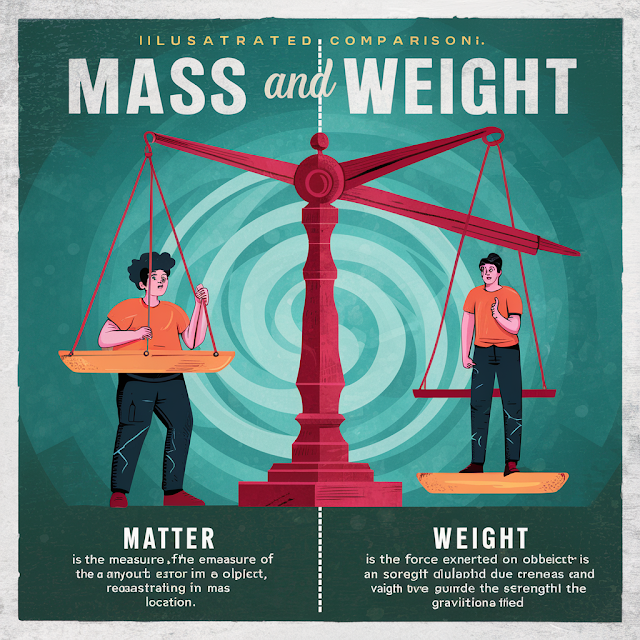What is The Difference Between Mass And Weight With Example ?
Mass and weight are often used interchangeably in casual conversation, but in physics, they refer to different concepts.
Mass:
Mass is a measure of the amount of matter in an object.
It is a scalar quantity, meaning it has magnitude but no direction.
Mass is constant regardless of the location of the object in the universe.
Mass is typically measured in kilograms (kg) or grams (g).
Example: Suppose you have a bag of apples weighing 2 kilograms. Whether you measure them on Earth, the Moon, or in space, their mass remains the same - 2 kilograms.
Weight:
Weight is the force exerted on an object due to gravity.
It is a vector quantity, meaning it has both magnitude and direction.
Weight varies depending on the strength of the gravitational field acting on the object.
Weight is typically measured in newtons (N) or pounds (lb).
Example: If you take the same bag of apples weighing 2 kilograms to the Moon, where the gravitational pull is weaker than on Earth, the weight of the apples will be less than it was on Earth. The mass remains the same (2 kg), but the weight is different due to the change in gravitational force.
In summary, mass is a measure of the amount of matter in an object, while weight is the force exerted on an object due to gravity. Mass remains constant regardless of the location, while weight varies depending on the gravitational field.
Here are some additional points of differentiation between Mass and Weight :
Mass:
1. Inertia: Mass is directly related to an object's resistance to changes in its state of motion. Objects with more mass have greater inertia, meaning they require more force to accelerate or decelerate.
2. Conservation of Mass: In any closed system, mass remains constant over time. This principle is fundamental in various scientific disciplines, including chemistry and physics.
3. Gravitational Interaction: Mass is also involved in the gravitational interaction between objects. According to Newton's law of universal gravitation, the gravitational force between two objects is directly proportional to the product of their masses.
Weight:
1. Gravitational Force: Weight is the force exerted on an object due to the gravitational attraction between the object and the planet or other massive body it is near. On Earth, weight is typically synonymous with the force exerted by Earth's gravity on an object.
2. Variation with Location: Since weight depends on the strength of the gravitational field, it varies depending on the location of the object. For example, an object will weigh less on the Moon compared to Earth because the Moon's gravitational pull is weaker.
3. Units: While mass is typically measured in kilograms or grams, weight is measured in newtons or pounds. This is because weight is a force, and forces are measured in units of newtons (in the International System of Units) or pounds-force (in the Imperial system).
Example:
Let's consider an astronaut with a mass of 70 kilograms. On Earth, where the acceleration due to gravity is approximately \( 9.81 \, \text{m/s}^2 \), the weight of the astronaut would be:
\[ \text{Weight} = \text{mass} \times \text{acceleration due to gravity} \]
\[ \text{Weight} = 70 \, \text{kg} \times 9.81 \, \text{m/s}^2 \approx 686.7 \, \text{N} \]
If the same astronaut were to travel to the Moon, where the acceleration due to gravity is much lower (approximately \( 1.625 \, \text{m/s}^2 \)), their weight would be significantly less:
\[ \text{Weight on Moon} = 70 \, \text{kg} \times 1.625 \, \text{m/s}^2 \approx 113.75 \, \text{N} \]
So, while the astronaut's mass remains the same (70 kilograms), their weight differs significantly depending on the gravitational field of the celestial body they are on.


Post a Comment